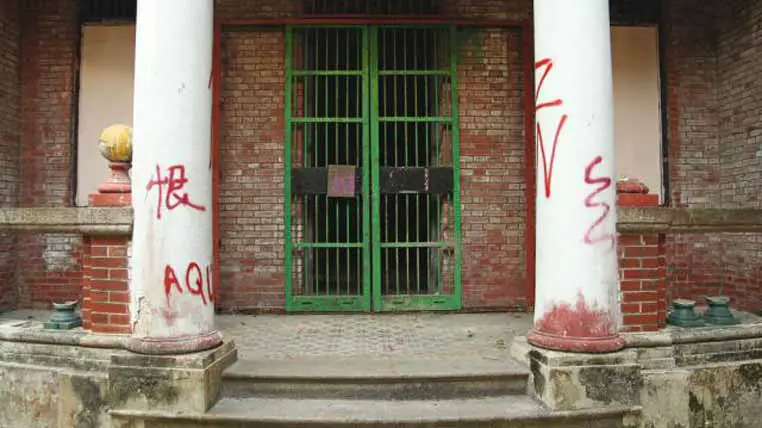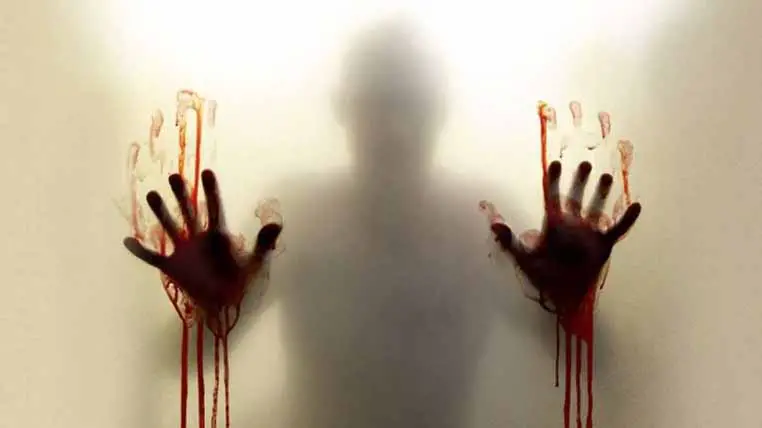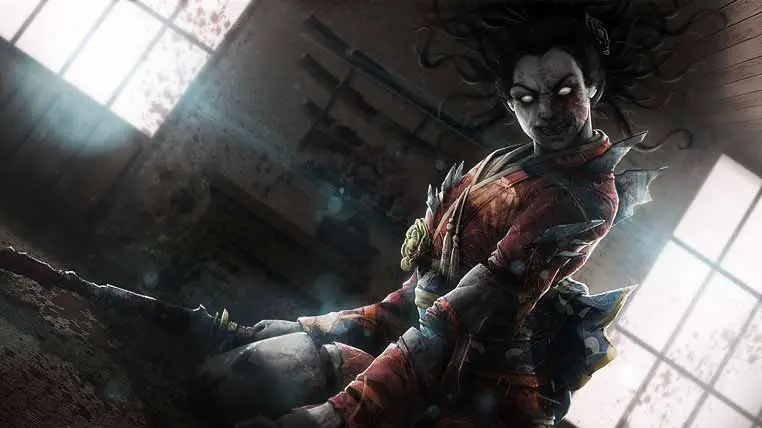Japanese urban legends are typically spooky stories closely linked to real places, events, and popular culture and often contain unsettling elements.
This article will explore four of the most frightening and enduring Japanese urban legends based on true events.
Japanese Urban Legends - Kuchisake-onna
The first terrifying Japanese urban legend is that of the vengeful spirit Kuchisake-onna, also known as “The Slit-Mouthed Woman.”
Kuchisake-onna is a malevolent spirit from Japanese folklore, described as the onryō (eng. “restless ghost”) of a woman abused and murdered by her jealous husband.
According to the legend, Kuchisake was a beautiful young woman who lived during the Edo period in feudal Japan. She was married to a powerful and influential samurai.
However, the man was highly jealous. He suspected his wife of infidelity, so one day, he followed her and discovered she was secretly meeting with another man.
Blinded by rage, the samurai brutally killed her lover, tied up Kuchisake, and dragged her to an isolated place.

He then carved her mouth from ear to ear, using a ceremonial knife, screaming: “Who will find you beautiful now?”
Ultimately, the jealous samurai cut off his wife’s head and threw her body into a nearby ravine.
Those who claim to have encountered Kuchisake-onna describe her as having long, black hair and pale skin, but she hides hideous deformities beneath the surgical mask that covers most of her face.
The legend rose in popularity in Nagasaki, Japan, in the late 1980s, during a series of violent crimes whose perpetrator remains unidentified to this day.
Some attributed the murders to a vengeful spirit that haunted the dark alleys in search of unsuspecting victims.
Soon, people began to connect the supposed entity with old Japanese urban legends, giving birth to the myth of Kuchisake-onna.
The hysteria surrounding the legend snowballed so much that authorities were forced to send police patrols to roam the streets every night to make the inhabitants feel safe.
Sensational seekers gave interviews claiming to have encountered Kuchisake-onna, describing how she approached them and asked, “Do you think I’m beautiful?”
Those who claimed to have survived encounters with Kuchisake-onna said that the response to her question had to be evasive.
If someone answered “No,” Kuchisake-onna would remove her mask, revealing her scars, and violently attack the victim.
If someone answered “Yes,” she would split their face from ear to ear, saying, “Now you’re as beautiful as me!”
Vague responses like “You’re an ordinary person” or “So-so” were meant to confuse the spirit, giving the victim enough time to escape.
The most recent alleged manifestation of Kuchisake-onna was reported in 2004 in South Korea after several mutilated bodies were found in a park.
Witnesses claimed to have seen a woman wearing a red surgical mask in the area, but the criminal was never identified.
Kuchisake-onna is a terrifying Japanese urban legend based on a true event that has endured for centuries.
It teaches us the consequences of jealousy, anger, and violence and the importance of being mindful of our words and actions.

Japanese Urban Legends - Nam Koo Terrace
Hong Kong has almost 8 million inhabitants and needs more housing. Every available space is used to its full potential for commercial, residential, or industrial purposes.
Nevertheless, somewhere on the outskirts of the metropolis lies an abandoned building in an advanced state of decay, surrounded by tall mesh fences and a grim warning: “Nam Koo Terrace. Do Not Enter! Highly Dangerous Area.”
The building, known as Nam Koo Terrace, hides a frightening history and is the source of a terrifying Japanese urban legend.
In the early 1900s, the construction was owned by a family of industrialists. However, they were forced to flee during World War II.
Thus, Nam Koo Terrace became an abandoned building transformed into a brothel where Japanese soldiers could “relax” with women forced to be their sex slaves.
The horrors committed by the Japanese are still embedded in the local memory after dozens of young women were raped, tortured, and brutally murdered in the tiny, dark rooms of Nam Koo Terrace.
According to local legends and stories, over 100 women died in Nam Koo Terrace during the Japanese occupation.
After the war ended, some members of the owning family returned to Hong Kong. The building was renovated and converted back into an imposing residence.
Nevertheless, strange events started to take place there.
One by one, all family members ended up dead. The deaths were cataloged either as suicides or accidental.
The owners of Nam Koo Terrace have changed over the last few decades. The land is currently owned by the real estate developer Hopewell Holdings.
This company requested approval to demolish the building and build a hotel, and the authorities approved the project.
However, the demolition has yet to take place.
When contacted by a reporter from a local publication, the company representatives refused to comment on the situation.
Instead of tearing down the Nam Koo Terrace, Hopewell Holdings erected a high mesh fence around the area and posted several warning signs cautioning people not to enter the demarcated area.
The locals speak of Nam Koo Terrace as an evil place emitting incredible negative energy.
It is said that the spirits of young women who suffered violent deaths inside Nam Koo Terrace still haunt the place. There are even several audio recordings depicting strange noises, female voices, and screams coming from within the building.
In the 1960s, another bizarre incident made the front page of the newspapers.
Called by neighbors disturbed by the sounds coming from inside Nam Koo Terrace, the police officers were attacked by a highly violent young woman who, according to official reports, ran out of the building and pounced upon the crew.
Two law enforcement officers were injured in the incident.
Another similar incident occurred in 2003 when a group of teenagers decided to test the “haunted house” theory.
Several young women, armed with cameras and camping gear, entered the building intending to spend the night there and record any paranormal activity that might happen there.
And the paranormal manifestations took little time to appear.
The behavior of three of the teenagers changed drastically shortly after the girls had set up their equipment.
Acting as if they were possessed, the girls started screaming, ripping their clothes, scratching, and hitting themselves, then jumped on their friends and started beating them.
A few witnesses who saw the girls entering the building called the police, and a crew was dispatched immediately.
The people in the area and the forces of order managed to get two teenagers out of the building. The girls were visibly agitated, bloody, and speaking in an unknown language.
Another four lifeless bodies were found in a room on the first floor of the building.
No less than 30 corpses have been found in or around Nam Koo Terrace from 2003 until today. All deaths were classified as suicides.
Some dead bodies were found on the higher floors, while others were found hanging by ropes from the trees in the backyard.
Those who have entered the building have said they are no longer willing to repeat the experience.
Several people have heard female voices, and some witnesses even claimed to have seen several young women decapitated walking in the corridors.
A few witnesses have declared that they saw a man dressed in a Japanese military uniform in one of the rooms on the first floor.

Japanese Urban Legends - Noh Mask
Noh masks are highly esteemed in Japan for their use in theatre and opera performances.
Each mask is carefully crafted and regarded as a genuine work of art. Those interested can purchase them from various souvenir shops, although the prices are pretty high.
However, a Japanese urban legend speaks of the “first Noh mask.” This legend has been circulating for over 1,500 years and is still narrated to interested children and grandchildren.
It is said that the first Noh mask was crafted around 500 AD.
The mask was simple, made of wood, and lacked the intricate decorations of modern Noh masks.
But this old mask possesses a peculiarity that makes it very special: it changes its expression when viewed from different angles.
It is said that all human emotions, from love and hate to joy and sadness, can be seen on the face of the first Noh mask if viewed from the right angle.
Yet, the Noh mask’s crafted technique remains a mystery.
One version of the Japanese urban legend speaks of a solitary and reclusive wood sculptor who worked tirelessly at crafting the mask.
According to this legend, the woodworker needed years to complete his work. When the mask was finally finished, the man collapsed and died.
When his body was found, he was wearing the Noh mask. Furthermore, people gathered around noticed a distorted expression of pain on the sculptor’s face.
And, to make the story even more disturbing, the man was so aged as if centuries had passed over him, leaving nothing except for an empty shell devoid of life. It was as if something had drained all the life force out of his body.
The Noh mask eventually ended up in the hands of one of the locals who had passed it down through many generations.
There are even accounts of wretched individuals who tried to destroy the mask. But every time, the story ended the same way – those who possessed the Noh mask were followed by a terrible curse.
According to this Japanese urban legend, the first Noh mask is not just a simple decorative object.
A demonic spirit resides in it, feeding on the energy of those around it.
Those who initially wear the mask receive good luck and wealth, but not for long, as the victims eventually lose everything they have gained with the help of the mask.
The Noh mask will always attempt to dominate its owner, creating a bond with the one who holds it and making them reliant on the gifts the mask can offer.
But all benefits come at a cost, and that price is the life of the one wearing the mask.
For centuries, the first Noh mask has been “moving” from one owner to another, feeding and growing stronger.
Many elders believe that among the thousands of Noh masks sold in Japan, there is also the cursed mask, seeking a new owner.

Japanese Urban Legends - The Red Room
The Red Room is a chilling Japanese urban legend about a teenager discovering a haunted website that brings unimaginable misfortunes to those who view it.
Despite not believing the story about a haunted website, the teenager still tries to research it and find more information about it. However, all his attempts prove futile, as if the website does not exist.
But one day, a red box suddenly appears in the bottom-right corner of his monitor. The tiny window displays an ad in a simple red frame with the question: “Do you like it?”
The boy tries to close the ad, but he can’t.
Suspecting a virus that has infected his computer, he runs an antivirus program, but the scan doesn’t identify anything suspicious.
Frustrated, the teenager tries various methods to get rid of the ad, including restarting the computer and rerunning the antivirus program. Still, the result is always the same – the small red box reappears in the bottom-right corner.
Frustrated, the teenager decides to click on the ad.
Then something strange happens as the text in the frame changes to “Do you like the r.” With each successive click, new letters appear, forming a sentence:
Do you like t
Do you like th
Do you like the
Do you like the r
Do you like the re
Do you like the red
Do you like the red r
Do you like the red ro
Do you like the red roo
As the young man was fixating on clicking the ad to reveal the whole sentence, he hadn’t even noticed the red box growing and eventually covering his entire screen.
He hadn’t noticed the weird buzzing sound filling his ears either. His head was heavier and heavier, and his sight grew blurrier by the minute.
But he couldn’t stop clicking the ad.
One more click revealed the message: “Do you like the red room?”
A few days later, the landlord found the teenager’s body after his parents reported his disappearance. The walls of his room were entirely covered in blood, leading the police to assume it was a suicide.
But this chilling Japanese urban legend doesn’t end there.
Another tragedy occurred on June 1, 2004, in Sasebo, Japan. Nevada Tan, a teenager, brutally murdered her classmate, Satomi Mitarai, after she posted mean comments about her.
Tan waited until she and Satomi were alone in the classroom, then she stabbed her multiple times, cut off both her arms, and used her victim’s blood to paint the classroom walls.
During the interrogation, Tan claimed that she saw nothing wrong with what she had done and that “this had to be done for everything to be alright.”
In the investigation, the police discovered that Tan’s laptop showed a tiny red frame in the bottom-right corner of the screen.
Inside the box was a text: “Do you like the red room?”
However, the police didn’t view the detail relevant to the investigation.
This chilling Japanese urban legend has been retold many times and still circulates today. It is a cautionary tale to those curious about the unknown and what lurks online.
At Ancient Theory we only use trusted sources to document our articles. Such relevant sources include authentic documents, newspaper and magazine articles, established authors, or reputable websites.
- Jen Jeffers - Creepy Tales About The Japanese Urban Legend Of The Slit-Mouthed Woman.
- Emily Matchar - Global Ghosts: 7 Tales of Specters From Around the World.
- Kuchisake-onna. wikipedia.org. [Source]
- Tatum Ancheta - 9 of the most haunted places in Hong Kong.
- Noh mask. mythus.fandom.com.
- Aaron Baggett - 7 Terrifying Japanese Urban Legends Based on True Stories.
- Iizuka Yoshiyuki - Japanese Urban Legends from the “Slit-Mouthed Woman” to “Kisaragi Station”.
- Fact or fiction? A collection of urban legends from around Japan. rakuten.com.
- Alicia Joy - Japan's Spookiest Urban Legends And Myths.






